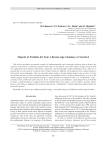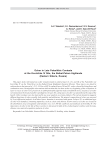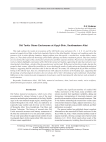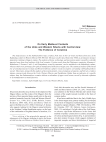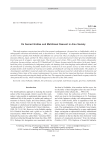Archaeology, Ethnology & Anthropology of Eurasia @journal-aeae-en
Статьи журнала - Archaeology, Ethnology & Anthropology of Eurasia
Все статьи: 524
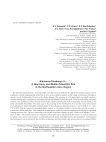
Nikolaevo-Otradnoye II-a new Early and Middle Paleolithic site in the Northeastern Azov region
Статья научная
We describe materials from a new Paleolithic site, discovered in 2020 on the right bank of Mius estuary, near its confl uence with the Taganrog Bay of the Sea of Azov, in the southern outskirts of the village of Nikolaevo-Otradnoye, which is in the Neklinovksky District of the Rostov Region. The clearing of a 10-meter-high river-bluff revealed a complex stratigraphy of subaqueous and subaerial Late and Middle Pleistocene rocks. Horizons with lithics and faunal remains were identifi ed. Cultural remains found in the coastal exposure and in the stratigraphic section belong to the Early and Middle Paleolithic. The early stage in the peopling of the Northeastern Azov and the Lower Don regions is documented by Early Paleolithic artifacts found in the subaqueous deposits of layers 5 and 6 (MIS 9–11, ~420– 270 ka BP). Heavil y waterworn patinated lithics include a core-shaped artifact, variou s types of side-scrapers, a scaled piece, fl akes, and chips. This complex is an informative addition to known complexes from the region, including contemporaneous ones. The most interesting is the Middle Paleolithic industry of layer 4 under the Kamenka (?) soil— layer 3, MIS 7. The toolkit consists of a diagonal side-scraper and a chip found in the section, as well as radial and Levallois cores, various side-scrapers, a par tly bifacial tool, spalls, and chips found in the denudation. Technological and typological criteria (primarily the Levallois technology) and the tentative date of non-waterworn patinated lithics make it possible to attribute them to the Early Middle Paleolithic of the southern Russian Plain. It is concluded that cultural remains of the Early Middle Paleolithic, dating to ~243–191 ka BP, have been found in the region for the fi rst time, fi lling the gap in the local Early Middle Paleolithic sequence. In adjacent regions, similar industries have been known since the late 1900s.
Бесплатно
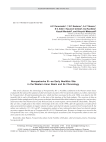
Novopetrovka III-an early neolithic site in the Western Amur basin and its chronology
Статья
This article discusses the chronology of Novopetrovka III—a Neolithic settlement in the Western Amur basin, evaluated by the radiocarbon analysis of charred remains on pottery. The Novopetrovka culture as a whole, represented by Novopetrovka I–III and Konstantinovka sites, which had been excavated in the early 1960s, was dated to the 5th (possibly 6th) to early 4th millennia BC on the basis of the typology of the blade industry. The overview of data on prismatic blades manufactured by the pressure technique demonstrated that blade industries appeared in a vast territory of Eurasia in the Final Pleistocene to Early Holocene and, in certain regions, survived until the Chalcolithic. Therefore, they are only a rough guide to the relative chronology of the sites. In the 1990s, after the appearance of radiocarbon dates generated from samples of organic remains in temper and charred remains on pottery from Novopetrovka II, the culture was redated to 15.5–10.8 cal BP. A comparative analysis of new radiocarbon dates based on charred remains on pottery suggests that the age of Novopetrovka III is 9.0–9.5 thousand years. Because no changes were traced in the Novopetrovka sites over a long period of time, the chronological assessment of the Novopetrovka culture in toto and of its separate sites is problematic.
Бесплатно
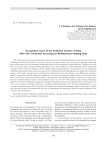
Статья научная
This study proposes a novel methodological approach to reconstructing the boundaries and structure of medieval settlements without relief features. In recent centuries, the areas of most sites were used for plowing, destroying their relief features. Erosion eventually redistributed the soil of the destroyed occupation layers. Therefore, not only the area of a site must be studied, but the adjoining areas as well. Tendencies in the distribution of the transported occupation layer mirror the thickness of the original culture-bearing deposits. Such estimates can be obtained by collating archaeological and science-based data. First, multispectral aerial photographs are subjected to statistical analysis. The results are then used to subdivide the settlement territory into smaller areas differing in vegetation density. Comparison with the results of geophysical, soil, and archaeological studies allows us to interpret those areas, to assess the state of preservation of the occupation layer (superficially disrupted, replaced, or transported). Previous multidisciplinary studies at the Kushman cluster of sites (9th–13th centuries AD) revealed substantial differences from the traditional classification (fortified settlement and group of unfortified rural settlements). Two sites can be defined as fortified settlements (Uchkakar and Kushmanskoye III), whereas Kushmanskoye II is an economic development area. The use of statistical analysis of multispectral imaging enabled us not only to confirm the previously proposed reconstruction, but also to substantiate the hypothesis about the initial boundaries and structure of the settlements.
Бесплатно
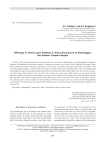
Offerings of Hunnic-type artifacts in stone enclosures at Altynkazgan, the Eastern Caspian region
Статья обзорная
Бесплатно
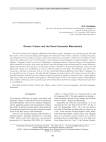
Okunev culture and the dene-Caucasian macrofamily
Статья научная
The article discusses the linguistic affi liation of the Okunev people. Arguments are cited favoring the idea that they spoke a Dene-Caucasian language belonging to the Yeniseian branch. This is indirectly evidenced by genetic and cultural ties between Okunev ancestors and Native Americans, by parallels to Okunev art in prehistoric China and on the northwestern coast of North America, and by Okunev type petroglyphs in northern Kashmir, where, in addition, a linguistic isolate is preserved—Burushaski, a language related to Yeniseian. Being a relict population, which remained in the place from where the Dene-Caucasian speaking tribes had migrated in various directions, Okunevans may have been ancestors of Yeniseians (another contender is the Karasuk population, whose ties with Okunevans remain to be established), as well as collateral relatives of Na-Dene, Sino-Tibetans, and other Dene- Caucasians. Alternative proposals, such as a Uralic, specifi cally Samoyed affi liation of the Okunev language, are less probable for several reasons. The idea that this language was Indo-Iranian, which almost necessarily follows from the hypothesis that the key role in Okunev origins was played by Yamnaya-Catacomb tribes, is quite unlikely. This idea is much more plausible with regard to Chaa-Khol people of Tuva, who display marked cranial affi nities with a number of Yamnaya and Catacomb groups and with Scythians of the Pontic steppes. Okunevans proper show no such affi nities.
Бесплатно
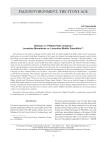
Oldowan or pebble-flake industry? Levantine Mousterian or Levantine middle Paleolithic?
Статья научная
The emergence of Levallois technique and the origin of the Levantine Middle Paleolithic, addressed in my previous publication, are revisited. In the fi nal Acheulean of the Levant, the Acheulo-Yabrudian industry emerged and the blade technology was invented. On that base, the Levantine Middle Paleolithic originated. The terms “Oldowan industry” and “Levantine Mousterian” should be abandoned. The Oldowan industry was associated with Homo habilis, who had never migrated outside Africa. Because early Middle Paleolithic industries originated from the Acheulo-Yabrudian industry of the Levant, they should be referred to as Middle Paleolithic rather than Mousterian. The Mousterian was associated with H. neanderthalensis, whereas the industries of territories where Neanderthals had not migrated should be referred to as Middle Paleolithic. Neanderthal migrations resulted in the emergence of Mousteroid industries in Eastern Europe, Caucasus, Crimea, southern Siberia, etc. In Africa, a new taxon Homo heidelbergensis (H. rhodesiensis) originated ca 800 ka BP. Eventually, those humans migrated to the Near East, as evidenced by the Gesher Benot Ya'aqov site. Throughout the Middle Pleistocene, Near Eastern, primarily Levantine populations were involved in the sapienization process. By the early Upper Pleistocene, two sister taxa had apparently originated there: anatomically modern humans (Skhul, Qafzeh) and Palestinian Neanderthals (Tabun, Amud, Kebara). There was no radical change in Acheulean or Middle Paleolithic industries in the Levant that might suggest immigration from Africa or the adjacent territories of Eurasia. Anatomically modern humans associated with the Nubian Levallois industry migrated from Africa to Arabia ca 110 ka ago. They may have had short-term contacts with Levantine Middle Paleolithic populations, but archaeological evidence of acculturation is lacking.
Бесплатно
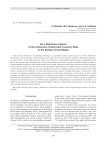
On a distinctive feature of the Andronovo (Fedorovka) funerary rites in the Baraba forest-steppe
Статья
Бесплатно
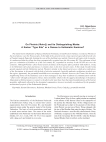
On phoinix and its distinguishing marks: a Karian “type site” or a demos to Hellenistic kamiros?
Статья научная
The oldest known inhabitants of Taşlıca (Bozburun Peninsula, in Southwestern Turkey), recorded as Phoinix in the inscriptions, were the Tloioi people. In the light of the ancient Greek corpus reported especially from the site of Fenaket (namely Rumevlek, forming the core of the dwelling zone) and the Classical wall ruins at the Acropolis, it is understood that the village has been systematically occupied since the 5th century BC. The settlement, which grew as a dominion of Kamiros as of the 3rd century BC, expanded its territory in the NE-SW axis over the centuries. Although Phoinix’s chess-board system of insulae of the megara offers parallels with Kamiros, owing to its Hellenistic-style plan and layout, it contains clues to far more ancient codes. In this study, besides being greatly equated with the Hellenistic period, Phoinix’s identity in the historical process, which gives indications of her Karianism, is discussed with the help of selective materials, basically authentic architecture tracked over the region. Apparently, the pyramidal monoliths were not unique to Phoinix; however, the Tloans, like the other neighboring komai on the mainland, seem to have managed to keep their traditions of communication with the “other world” through such features. Hence, these monoliths, which evoke the ziggurat morphology or the famous Mausoleum at Halicarnassus to connect to the afterworld, must have been the typical manifestations of the Karian mentality, sufficiently reflected by the aboriginal communities, however inevitably overshadowed by the grandest architectural projects of the Hekatomnid dynasty.
Бесплатно
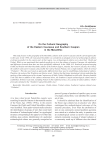
On the Cultural Geography of the Eastern Caucasus and Southern Caspian in the Mesolithic
Статья научная
This study focuses on the geography of the Mesolithic cultures of the eastern Caucasus and the current approaches to this topic. In the 1970s, the Caucasian Mesolithic was considered an amalgam of several archaeological cultures evolving in parallel. In the eastern part of that region, two archaeological cultures were described: Chokh and Trialeti. While no one questioned their marked specifi city vis-à-vis the cultures of western Caucasus, the similarities and differences between them have not been specifi cally addressed. In the 1990s, S.K. Kozłowski proposed merging Chokh and Trialeti with other Mesolithic cultures of the northern Zagros, Anatolia, the western Caucasus, the Crimea, the southern and eastern Caspian, and possibly the Central Iranian Plateau, into a single industry, which he termed “Trialetien”. This idea was based on approaches different from those used in establishing archaeological cultures. Therefore, the notion of the Trialetien was likewise novel. I believe that the former typological criteria underlying the typology of the southern part of the circum-Caspian area (Chokh, Trialeti, Balakhan) are still valid. Likewise plausible is the idea that in addition to the cultures mentioned above, the Southern Caspian archaeological culture must be established. All those local units, including Trialeti (in the traditional sense), are a group of related cultures, which I previously included in the “Southern Caspian Mesolithic area”.
Бесплатно
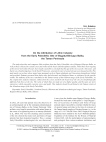
Статья научная
The study describes and compares lithic artifacts from the Early Paleolithic site of Bogatyri/Sinyaya Balka, as well as those collected in coastal screes and on the nearby beach. Interdisciplinary studies, which have been ongoing at the site for more than 20 years, have made it possible to conclude that the age of the site exceeds 1 mln years, and that it was a butchering place. In the Early Pleistocene, a lacustral crater of a mud volcano was situated nearby. This mud marsh was a place where many large mammals such as Taman elephants and Caucasian elasmotheres bathed and perished. Humans procured them before they had drowned, and butchered them, as evidenced by the specifi c toolkit. The industry of the site is attributed to the Taman variety of the Oldowan stage of the Early Paleolithic. As the comparative analysis indicates, lithics from the screes and from the beach near the site are morphologically different from those at the site. The rocks of which they are made are of a higher quality, and the types are more expressive, which especially concerns cores and spalls. This industry should be attributed to the Taman variety of the Acheulean stage of the Early Paleolithic.
Бесплатно


